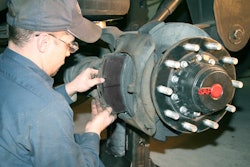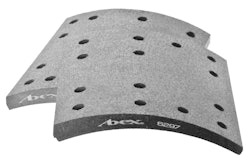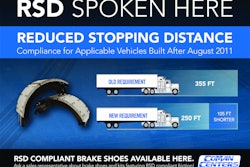
[This article was originally published in 2014 by Trucks, Parts, Service. It has been updated to include more timely information.]
It’s been more than a decade now since the National Highway Traffic Safety Administration (NHTSA) published its final ruling updating Federal Motor Vehicle Safety Standard 121 – Air Brake Systems, and re-introduced commercial trucking to reduced stopping distance (RSD).
Written with compliance dates in 2011 and 2013, the 2009 ruling forced OEMs and brake manufacturers to reduce emergency stopping distances for their new tractors by an astonishing 30 percent.
Though it wasn’t easy, OEMs eventually succeeded in meeting the regulations, and RSD technology is standard on all new heavy-duty trucks.
But now, with RSD compliant trucks constantly flowing into the aftermarket, the technology faces its next challenge — adoption.
Because FMVSS 121 only requires new tractors to meet RSD regulations, vehicle owners don’t have to accept the technology in the aftermarket.
But with clear safety and performance benefits, brake suppliers say the lack of an aftermarket regulation shouldn’t stop distributors from stocking RSD-compliant products.
On the contrary, now that customers are accustomed to RSD, suppliers say there’s an opportunity in the aftermarket for distributors willing to stock the slightly higher priced, but also higher performing components.
“There are a lot of safety-conscious fleets out there that want to maintain the same braking and stopping performance they have on their new trucks,” says Tim Bauer, business unit director, undercarriage products, aftermarket at Meritor. “To do that, you have to replace like for like.”
The story of today’s RSD regulations began in 2005, when NHTSA first expressed an interest in shortening the braking distances for commercial vehicles.
[RELATED: Carriers at TMC meeting share frustrations with their dealer partners]
Citing a braking distance then nearly double most passenger cars, NHTSA suggested an amendment to FMVSS 121 “to reduce the required stopping distances for the loaded and unloaded service brake distances and emergency brake distances for truck tractors by 20 to 30 percent.”
The proposal was followed by more than three years of extensive testing and industry research.
It was during this time that the Heavy Duty Brake Manufacturer’s Council became involved, says Randy Petresh, vice president, technical services at Haldex.
“[HDBMC] had regularly scheduled meetings with NHTSA while the standard was being developed,” he says. “A lot of time went in to determining how much of a reduction [in stopping distance] they really wanted.”
In July 2009 NHTSA announced its new stopping distance requirement. This reduced the maximum stopping distance for loaded three-axle tractors from 355 ft. to 250 ft., and unloaded tractors to 235 ft.
Given lead time before Phase I of the FMVSS 121 amendment would take affect (Aug. 1, 2011), brake system and friction manufacturers immediately began testing concepts that would meet the RSD requirements.
The two sides worked together to hit the 2011 deadline.
“There was cooperation between the brake manufacturers and friction suppliers from the initial concepts all the way to the fleets,” says John Thompson, sales manager, commercial vehicles, NAFTA at TMD Friction.
Higher friction brake linings were identified as early on as 2007 by the brake manufacturers as part of a package (also including larger diameter and wider front brakes, as well as brake chamber size increases) that would meet RSD requirements, says Tom Rogers, senior applications engineer, Abex commercial vehicle friction at Federal-Mogul Motorparts.
Previous to RSD, most friction materials were classified as NAO or non-asbestos organics. In addition to new NAO materials, Rogers says Federal Mogul also developed semi-metallic friction solutions, as well as combination NAO/ semi-met solutions.
Each solution was capable of producing the torque required to stop the vehicle in their particular applications, but the semi-metallic and combo solutions also were better able to resist heat and fade at the higher loadings – helping to reduce stopping distance, Rogers says.
“RSD drive axle brake linings show improved speed spread effectiveness by reducing the in-stop fade characteristic, seen in regular friction materials,” add the Fras-le duo of Alexandre Casaril, development engineer, and Bernard de Jong, project engineer. “RSD drive axle brake linings are considerably less susceptible to thermal conditioning in order to obtain the nominal designed performance level, resulting in high stable, stopping power since first brake applications.”
Brake manufacturers also expanded conventional steer axle drum brake sizes from 15 in. x 4 in. to 16.5 in. x 5 in. and rear axle brake widths from 7 in. to 8 in. for most OEM applications.
[RELATED: What to look for when inspecting brake drums]
Bauer says the different sizes were required as the amount of braking done by each axle changed.
“A larger brake was required to handle the amount of torque that would be required for such a dynamic stop,” says Petresh. “The 15 in. x 4 in. brake had been the primary steer axle for more than 20 years, and it had always been overloaded.”
The smaller brake’s preference over the 16.5 in. x 5 in. brakes was the result of its lighter weight and maneuverability, says Gary Ganaway, director of marketing and global customer solutions at Bendix Spicer Foundation Brake, LLC. “Before RSD, [16.5 in. x 5 in.] brakes were purely optional and were only adopted by fleets looking for longer brake life,” he says.
Larger brakes also helped meet RSD regulations by extending system life and aiding in heat transfer.
“RSD materials have to be more aggressive to reach their stopping distance requirements, and that causes the entire braking system to run a little bit hotter,” says Johnathon Capps, vice president, engineering at Webb Wheel Aftermarket. “Without any changes, that excess heat would cause the system to wear at a much faster rate.”
Rear axle brakes also were slightly tweaked to reduce fade and extend useful life, says Thompson.
Now three years removed from the RSD amendment’s implementation, suppliers say customers have quickly grown to appreciate the benefits reduced stopping distances provide.
“Fleets are starting to see the economic and safety benefits of RSD technology, and drivers in particular are really responsive,” says Ganaway. “They have a vested interest in braking performance, and RSD [compliant] systems give them a lot more confidence out on the road.”
Adds Tom Rogers, senior applications engineer, Abex commercial vehicle friction at Federal-Mogul Motorparts, “Customers like the way they feel when they’re using them.”
It’s those benefits that distributors should focus on in selling RSD in the aftermarket, suppliers say. Once a driver gets used to reduced stopping distances, downgrading to conventional brakes can be problematic or downright hazardous.
“I think most fleets want to maintain a similar level of performance in their braking systems as they had when they first bought their vehicle,” says Dennis Griffin, product manager, commercial vehicle friction at Federal-Mogul.
“I think making a conscious decision to not maintain a consistent level of performance on a vehicle is becoming much more difficult,” says Randy Petresh, vice president, technical services at Haldex. “Years ago if something worked [customers] would it use forever, it didn’t matter if something better came along.
“Now you see more and more customers looking at safety and performance in the aftermarket, and I think that’s a good thing.”
Bendix says NHTSA estimates reduced stopping distances save approximately 227 lives and more than $169 million in property damage from accidents per year.
“Braking is one of those technologies where you don’t understand its full capabilities until you need it,” Ganaway says. “That’s why we spend a lot of time educating our [customers] and making sure they know what to ask for when ordering replacement parts.”
“We can save lives with this technology,” adds Fabio Jurchaks, director of sales and engineering, NAFTA at TMD Friction. “That’s one place where we’ve really tried to educate fleets; they need to be very conscious about the friction formulas they spec’ [in the aftermarket]. Spending a few cents more can ensure the truck always stops when it should.”
Today’s heavy-duty brake and friction manufacturers all offer RSD compliant aftermarket brake products designed specifically to meet the needs of safety and performance-focused fleets.
Simply put, turning to an inferior aftermarket component after using RSD technology compromises a tractor’s braking performance.
“When truck operators ask which part they should use, our district sales managers always reply, ‘Purchase the exact same part spec’ that came with the vehicle from the factory,’” says Craig Frohock, vice president, aftermarket and trailer at Meritor. “A component that ‘just fits’ a given make and model may not necessarily meet the customer’s need for performance, longevity and, especially, value.”











